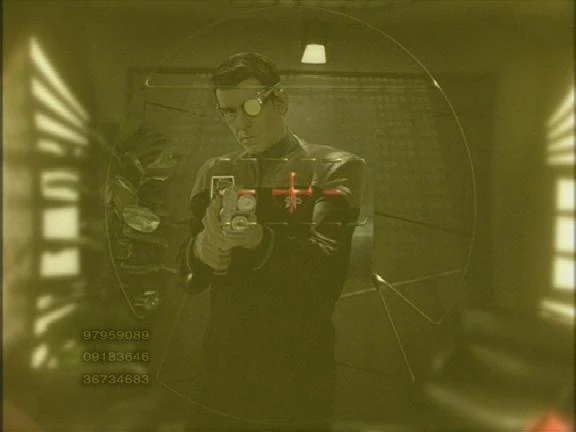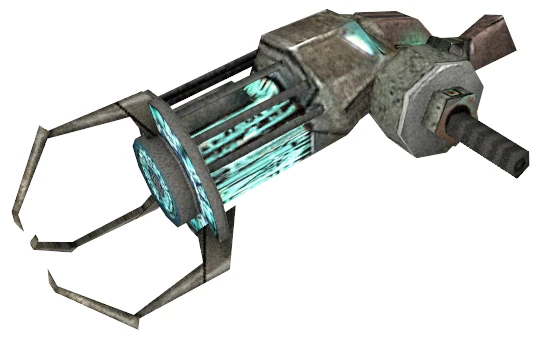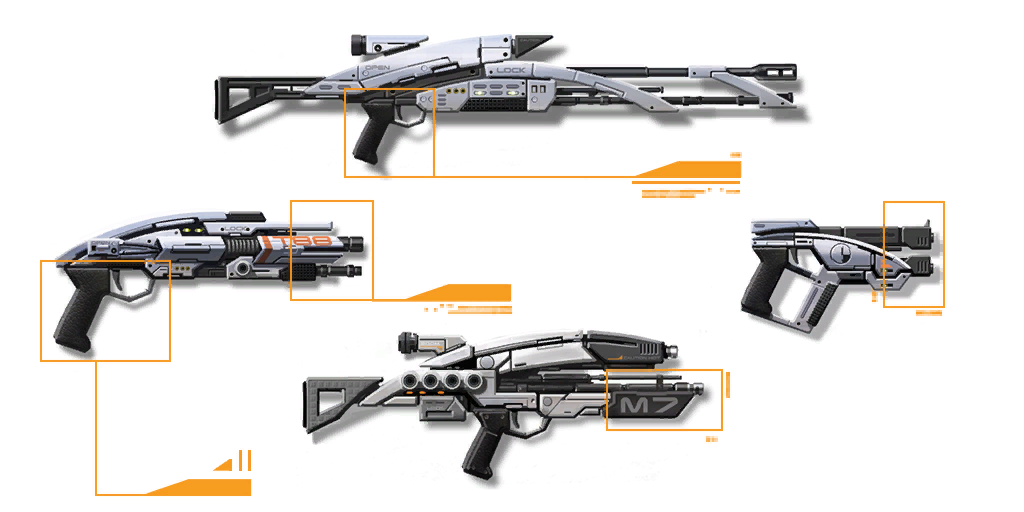My Top 5 Favorite Handheld Science Fiction Weapons
I feel that I should establish my nerdiness with my first blog post, so I'm delving into the realm of sci-fi. No not SyFy. They can take their sharknados and cram them.
Science fiction has always been full of crazy new weapon ideas because humans, including writers, are obsessed with violence. Many of the most impressive ones are on a very large scale; superviruses, bombs, nanobot swarms, space stations shaped like dented basketballs that shoot 8 huge lasers into each other to make on even huger laser that blows up planets, etc. Still, in many cases I find the handheld weapons are more interesting. Handheld weapons are used by characters against other characters, and characters are better able to hold my interest than even the best CGI ships, buildings, or planets exploding.
I'm going to leave the really popular ones out of my list. Everyone knows about the lightsabers of Star Wars and the phasers of Star Trek, and the internet is just dripping with minutia about every thing that every character in every installation of those franchises ever did with those weapons. There is also slash fiction delving into the minutia of every alternative use fanboys/fangirls have ever conceived of for those weapons, but I digress. Without further ado, here are my top 5 handheld science fiction weapons.
5. The Sonic Device (Hands of Blue) - Firefly
Joss Whedon's beloved Firefly series featured a lot of weapons, most of which were normal guns that shot bullets but made pew-pew noises (except in the pilot and the Serenity movie where they made normal gun noises because consistency is for suckers.) A much more interesting weapon was used by the blue-gloved agents (referred to by fans as the Hands of Blue) that were tasked with hunting down the government test subject River Tam. The Hands of Blue used a handeld sonic device that used high frequency sound waves to trigger intense hemorrhaging in everyone with in earshot, causing blood to pour out of pretty much everywhere. The aftermath made it seem like everyone in the room but the two agents suddenly died of late-stage Ebola hemorrhagic fever. It's never made clear how the agents resist their own weapon's effects; the only obvious visual cue is the blue nitrile gloves. This is why I always have nitrile gloves on hand.Part of the appeal of the sonic device is how its design contrasts the rest of the show's aesthetics. The majority of Firefly is set on backwater planets on the edge of inhabited space that have a decidedly wild west feel to them. Many of the weapons carried by the show's characters are of ageing design by todays standards, with one of the main protagonists even carrying a cut-down lever action rifle. The Hands of Blue are from the more civilized inner planets and this is reflected in their weapons design. It is a small, shiny, metallic box with two blue, glowing tubes that deploy from either end when activated. The clean lines and glowy bits remind you that this is a product of the future and of the disparity that exists between the high tech cities of the inner planets and the wilderness of the frontier worlds.
Also of note is that this weapon's function is entirely different from all of the others depicted in the Firefly universe. The show's protagonists and the other people of the frontier worlds all carry guns because they are fighting for their survival and that of their friends and allies. The Hands of Blue carry their weapon primarily for murdering witnesses and they have no intention of trying to save anyone, so their device is imprecise and indiscriminate. Despite the fact that the Hands of Blue have few lines they are instantly characterized as sociopaths, which can be hard to do in a television show where even some of the sympathetic protagonists are egregiously violent.
4. Chu'lak's TR116 Sniper Rifle - Star Trek: Deep Space 9
The phaser is without a doubt the signature weapon of Star Trek, and its versatility would put it at the top of my list if it were a weapon that hadn't already been discussed to death in all corners of the internet. The Star Trek universe includes many other weapon designs as well, including mundane projectile weapons like the TR116. The TR116 is a Starfleet weapon design that fires projectiles using gunpowder, and on it's own would be no more interesting than a modern rifle save for an interesting shape and caseless ammunition. In the hands of the unstable Vulcan science officer Chu'lak, however, it became one of the more interesting weapons cooked up by the star trek writers. Chu'lak fitted his rifle with a exographic targeting sensor, which is a bunch of sciency sounding mumbo jumbo that basically means a scope that can see through walls. The scope that sees through walls is actually a fairly common idea in science fiction but it is usually just used for tracking targets behind concealment or for shooting a powerful projectile through cover. The really unique feature of Chu'lak's rifle was that he fitted it with a micro-transporter that allowed him to teleport the projectile from the gun's muzzle to just in front of the target while retaining the projectile's forward momentum.This combination of technologies allowed Chu'lak to kill someone from anywhere in the space station while making it look like the shooter was in the same room. The rifle left no powder burns on the target and the transporter device didn't produce a traceable energy signature. That sort of weapon could wreak untold havoc if used by a crafty assassin. When protecting a VIP from danger, body guards have to make sure that they have to secure all locations that could provide a sniper a line of sight on the VIP. They can take advantage of indoor spaces and secured buildings to limit the danger to the VIP so that they only have to secure the immediate area. If an assassin could see and shoot through walls, the security force would have to secure the entire area within the effective range of the rifle. Of course, Star Trek plots regularly involve sending ship captains and other high-ranking officers into danger for no good reason, so they probably don't care much about assassination attempts anyway.
3. The Dark Energy Gravity Gun - Half Life 2
The gravity gun from Half Life 2 was the game's signature weapon. "Gravity gun" was a nickname for a tool officially designated the "zero point energy field manipulator" despite the fact that gravity and zero-point energy are completely different things and the game's protagonists (who were all quantum physicists) really should have known better. Through most of the game the gun functions primarily a tool for solving physics-based puzzles. It could attract and lift heavy objects and then drop them or forcefully launch them away, and it is only useful as an improvised weapon when there is an object around suitable for use as a projectile. Towards the end of the game, however, a disarmament field (which was bad at its job in the most ironic way possible) turns the tool into a weapon of immense destructive power.The disarmament field infused the gun with large amounts of dark energy. I have no clue what dark energy does in real life, but in the game it caused the gun to disintegrate anything that got caught in its energy field, allowing it to kill any enemy instantly. It also gained the ability to pickup heavier objects and throw them farther and any object it threw disintegrated other objects on contact. Disintegrating everything makes the gun pretty useless for solving the game's signature physics puzzles, but it was a super cool energy weapon that did a nice job of finishing the game off with a solid hour of wanton destruction.
2. Mass Drivers - Mass Effect (The First One)
He mass driver weapons in Mass Effect (handily explained here) were a unique takes on the future evolution of basic firearms. They were made to emulate characteristics of modern assault rifles, submachine guns, sniper rifles and handguns, but they used fictional, pseudosciencey, "mass effect" fields to launch their projectiles. I think this idea was a great one. Modern weapon designs are very efficient as far as ergonomics, user friendliness, and combat efficiency go, and many science fiction weapons seem like a step back in many ways. For example, the blasters of Star Wars have low firing rates and slow projectiles and the phasers of (pre-Abrams) Star Trek produce a beam that gives away the shooter's location and has an egregiously long firing phase.The mass drivers in Mass Effect used futuristic technology to become more versatile and efficient without loosing any of the efficiency of a modern weapon. They took advantage of the mass effect mechanism to make lightweight weapons that fold and deploy automatically when they are holstered and drawn, allowing a soldier to carry 4 or 5 weapons in the field. One soldier can transition from a sniper role to close quarters combat without having to settle for using a sub-optimal weapon in either role. Many of the weapons also included built-in, low-profile optical sights that collapsed into the folded weapon, eliminating issues with the added bulk and snagging potential that can be problematic when using modern scopes. Mass drivers were also depicted as having universal interchangeable parts, allowing the user to easily install aftermarket components and change the way the weapon functions.
Another huge advantage of the mass driver over a standard firearm was the way it handled ammo. Mass drivers shaved tiny projectiles from a solid block of metal with each shot and made up for the lack of projectile mass with an extremely high muzzle velocity. One block could provide the weapon to hold over a thousand rounds at once, giving them effectively infinite ammunition capacity for the purposes of a single fire fight. The limiting factor in sustained fire was heat buildup, which was handled through a built in heat sink and a cooling system that would automatically shut the firing mechanism down before things got dangerous. The projectile block could be made of different materials, so the mass driver could use bullets that did cool stuff like explode or give people lingering radiation poisoning.
Unfortunately, the mass drivers in the Mass Effect sequels lost some of their nifty properties for gameplay reasons. Mass Effect 2 eschewed the heat dissipation system for disposable heat sinks that worked more like traditional magazines, albeit ones the size of a poker chip. It also eschewed the interchangeable modifications for weapon-specific upgrades. Mass Effect 3 simplified the upgrades further and added in tacky looking external weapon attachments that ruined the sleek lines of the weapons. The dumbing down of the guns in the second game was ignored by most fans in light of the improved combat system, and the dumbing down of the guns in the third game was ignored by most fans in light of the craptastic ending.
1. The De-mat Gun - Doctor Who
Doctor Who isn't a sci-fi show that is usually associated with weapons of any sort, especially guns. The Doctor has denounced guns through all of his incarnations, instead preferring to kill large numbers of his enemies in more roundabout fashions. Since the revival of the show in 2005, the Doctor has been pretty good about not shooting things, but some of his older incarnations didn't always practice what they preached. The fourth Doctor even made his own rifle once, the De-mat gun.The De-mat gun was a powerful, forbidden weapon of the Time Lords which could completely remove its target from the time-space continuum, meaning that its victims retroactively never existed. The fourth Doctor hypnotized his barbarian companion, Leela, and forced her to build this weapon (the most advanced in the universe) under the direction of a robotic dog which was downloading the weapon's schematics through a golden headband. Yes I know how weird that sounds.
The Doctor uses the De-mat gun to kill two enemies on his home planet of Gallifrey in the Invasion of Time serial. The first was a random Sontaran who sacrificed his life for the sake of exposition. The second was the Sontaran leader, Stor. Stor was killed while setting off a bomb that would destroy the spray-painted cardboard prop that allowed the Time Lords to travel through (and lord over) time. Killing Stor with the De-mat gun made the bomb disappear from existence mid-explosion because Stor never existed to bring it there or set it off. Handily, all of the other Sontarans disappeared because they never had anyone to lead them to Gallifrey. The gun also made itself disappear and erased the doctor's memory of ever building it because his motivation to do so ceased to have ever existed. That is some serious firepower for handheld weapon, especially one that was built in ten minutes by a handless robot and a knife-wielding barbarian.
Besides being an all-around nifty weapon, the De-mat gun raised some serious questions about its own history. The Doctor stated that the weapon was forbidden to exist and had never been built before, but his own De-mat gun erased all evidence of its own existence after it had killed the enemy that motivated the Doctor to build it. In theory the Time Lords could have built a De-mat every other Thursday to get them out of some random conflict and nobody would have ever known.





No comments:
Post a Comment